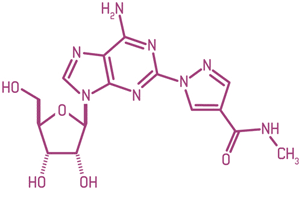Mode of action
Rapiscan is a selective, low-affinity, and therefore short-acting, A2A adenosine receptor agonist that can be administered as a 10-second intravenous injection without the need for weight-based dosing.1,2
Clinical trials show Rapiscan to be as effective as adenosine in the generation of a hyperaemic response, and in detecting the presence and extent of reversible perfusion defects.3,4
Figure. Regadenoson

References
- Rapiscan Summary of Product Characteristics (Download)
- Zhao G, Linke A, Xu X et al. Comparative Profile of Vasodilation by CVT-3146 (regadenoson), a Novel A2A Receptor Agonist, and Adenosine in Conscious Dogs. JPET 2003; 307:182–189
- Lieu HD, Shryock JC, von Mering GO, et al. Rapiscan, a selective A2A adenosine receptor agonist, causes dose-dependent increases in coronary blood flow velocity in humans. J Nucl Cardiol 2007;14:514-520 (View abstract)
- Cerqueira MD et al, on behalf of the ADVANCE MPI Trial Investigators. Effects of age, gender, obesity and diabetes on the efficacy and safety of the selective A2A agonist Rapiscan versus adenosine: integrated ADVANCE MPI trial results. J Am Coll Cardiol 2008;1:307-316 (View abstract)






